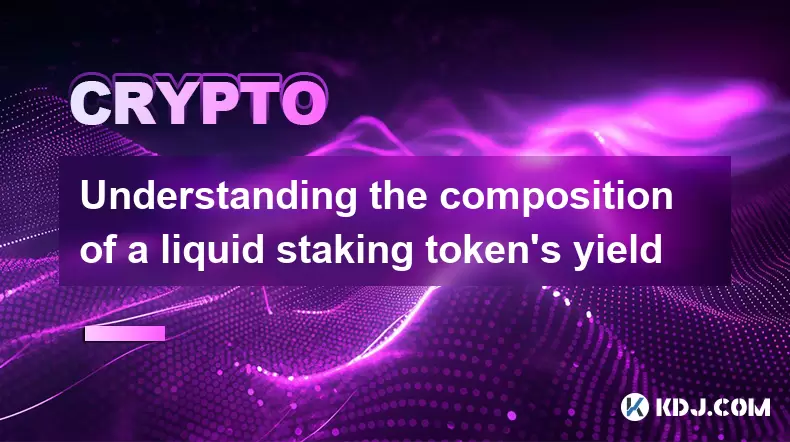-
 bitcoin
bitcoin $103128.103252 USD
-3.33% -
 ethereum
ethereum $3437.127692 USD
-4.86% -
 tether
tether $0.999700 USD
-0.02% -
 xrp
xrp $2.403993 USD
-5.73% -
 bnb
bnb $961.374676 USD
-4.11% -
 solana
solana $154.938665 USD
-8.18% -
 usd-coin
usd-coin $1.000113 USD
0.03% -
 tron
tron $0.298122 USD
0.30% -
 dogecoin
dogecoin $0.172428 USD
-5.76% -
 cardano
cardano $0.557625 USD
-7.13% -
 hyperliquid
hyperliquid $38.740701 USD
-6.51% -
 chainlink
chainlink $15.306051 USD
-7.51% -
 bitcoin-cash
bitcoin-cash $507.558648 USD
-3.26% -
 stellar
stellar $0.281899 USD
-6.74% -
 unus-sed-leo
unus-sed-leo $9.241811 USD
0.57%
Understanding the composition of a liquid staking token's yield
Liquid staking tokens let users earn staking rewards while maintaining liquidity, as these tokens represent staked assets that can be traded or used in DeFi for added yield.
Jul 20, 2025 at 09:07 am

What Is a Liquid Staking Token?
A liquid staking token is a representative asset issued to users who stake their native cryptocurrency on a proof-of-stake (PoS) blockchain. Instead of locking up assets during the staking period, users receive a token that mirrors their staked amount and can be freely traded or used within decentralized finance (DeFi) protocols. These tokens derive value not only from the principal staked but also from the yield generated through staking rewards.
For example, if you stake ETH on Ethereum 2.0 through a platform like Lido Finance, you receive stETH in return. This token continues to accrue value as staking rewards are added to the underlying asset. The yield component of such tokens is crucial in determining their long-term utility and market price.
Components of Yield in Liquid Staking Tokens
The yield of a liquid staking token is composed of multiple elements, each contributing to the overall return for the token holder.
- Staking Rewards: These are the base rewards provided by the PoS network for validating transactions and securing the network. For instance, Ethereum offers annual staking rewards based on the total amount of ETH staked across the network.
- Protocol Fees: Some liquid staking platforms charge a fee for managing the staking process. While this doesn’t directly add to the yield, it affects the net return received by the token holder.
- DeFi Yield Opportunities: Many liquid staking tokens can be used as collateral or liquidity in DeFi protocols, generating additional yield through lending, liquidity provision, or yield farming.
Each of these components plays a role in shaping the overall yield structure of a liquid staking token. Understanding how these components interact is essential for evaluating the token’s performance over time.
How Staking Rewards Are Distributed
Staking rewards in a liquid staking system are typically reinvested automatically into the underlying asset. This process increases the token's value over time, often referred to as a rebase mechanism.
- In platforms like Lido, the staking rewards earned are periodically added to the total pool of staked assets.
- The liquid token (e.g., stETH) is then revalued to reflect the increased amount of staked ETH plus rewards.
- This means that a user holding 1 stETH today will have slightly more than 1 ETH equivalent in the future due to the compounding of staking rewards.
The frequency of these rebases can vary by platform and blockchain. It’s important for token holders to understand how often these adjustments occur and how they are calculated.
Impact of Protocol Fees on Net Yield
While the staking rewards form the backbone of yield, protocol fees can significantly influence the net return for token holders.
- Most liquid staking platforms charge a fee ranging from 5% to 15% of the staking rewards earned.
- This fee is deducted before the rewards are distributed back to the token holders.
- Users should compare these fees across platforms to ensure they are getting the most favorable yield structure.
For example, if the Ethereum network offers a 4% annual staking yield and a platform charges a 10% fee, the effective yield for the user becomes 3.6% after deducting the fee. This calculation is critical for investors seeking to maximize their returns.
Integrating with DeFi Protocols for Additional Yield
One of the key advantages of liquid staking tokens is their interoperability with DeFi applications. Users can deploy these tokens in various DeFi protocols to generate additional yield.
- Using platforms like Aave or Compound, users can lend their liquid staking tokens and earn interest.
- Providing liquidity in decentralized exchanges such as Curve or Balancer can also generate liquidity provider (LP) rewards.
- Some protocols offer incentive tokens for depositing liquid staking tokens, further boosting the yield.
However, this additional yield comes with increased risk, including impermanent loss, smart contract vulnerabilities, and fluctuating token values. Users should carefully assess these risks before engaging in DeFi activities with their liquid staking tokens.
Frequently Asked Questions
1. How does the rebase mechanism affect my liquid staking token balance?The rebase mechanism increases the token’s value by adding staking rewards to the total pool. Your token balance remains the same, but each token represents a slightly larger amount of the underlying asset over time.
2. Can I unstake my tokens anytime?Unstaking may not be immediately possible due to network restrictions or platform-specific withdrawal queues. For example, Ethereum’s Beacon Chain requires a waiting period before staked ETH can be withdrawn.
3. Are liquid staking tokens considered stablecoins?No, liquid staking tokens are not stablecoins. Their value fluctuates based on the performance of the underlying staked asset and the accrued yield.
4. What happens to my yield if the protocol is hacked?If a liquid staking protocol suffers a security breach, both the principal and accrued yield may be at risk. It’s important to use platforms with strong security audits and insurance coverage.
Disclaimer:info@kdj.com
The information provided is not trading advice. kdj.com does not assume any responsibility for any investments made based on the information provided in this article. Cryptocurrencies are highly volatile and it is highly recommended that you invest with caution after thorough research!
If you believe that the content used on this website infringes your copyright, please contact us immediately (info@kdj.com) and we will delete it promptly.
- XNO, BTC, Decred: Navigating Crypto Tides with Nano's Surge and Decred's Dip
- 2025-11-12 14:40:01
- BONK Price Swings: Insider Trading Whispers and the Meme Coin Rollercoaster
- 2025-11-12 15:05:01
- Ethereum, Altcoins, and Long-Term Gains: Navigating the Crypto Landscape
- 2025-11-12 09:00:00
- Strategy Shares, Bitcoin Retreat, and Market Pain: A NYC Perspective
- 2025-11-12 08:55:01
- Taft, Veterans, and Salutes: A Presidential Honor
- 2025-11-12 09:00:00
- Cryptos, Breakout, and Meme Coins: What's the Haps?
- 2025-11-12 09:40:01
Related knowledge

Understanding the composition of a liquid staking token's yield
Jul 20,2025 at 09:07am
What Is a Liquid Staking Token?A liquid staking token is a representative asset issued to users who stake their native cryptocurrency on a proof-of-st...

Is it better to stake directly or use a liquid staking service?
Jul 22,2025 at 08:21pm
Understanding the Basics of StakingStaking in the context of blockchain and cryptocurrency refers to the process of locking up digital assets to suppo...

What to do during an LST depeg event
Jul 20,2025 at 04:57pm
Understanding LST Depeg EventsAn LST (Liquid Staking Token) depeg event occurs when the token, which is typically pegged to the value of the underlyin...

How to find new liquid staking projects
Jul 30,2025 at 01:14pm
Understanding Liquid Staking and Its ImportanceLiquid staking is a mechanism that allows users to stake their cryptocurrency assets while still mainta...

Can you provide liquidity with liquid staking tokens?
Jul 22,2025 at 10:22am
Understanding Liquid Staking TokensLiquid staking tokens (LSTs) are derivative tokens that represent staked assets on a proof-of-stake (PoS) blockchai...

What are the best wallets for storing LSTs?
Jul 21,2025 at 03:14pm
Understanding LSTs and the Need for Secure StorageLSTs, or Liquid Staking Tokens, are derivative tokens representing staked assets on a blockchain. Wh...

Understanding the composition of a liquid staking token's yield
Jul 20,2025 at 09:07am
What Is a Liquid Staking Token?A liquid staking token is a representative asset issued to users who stake their native cryptocurrency on a proof-of-st...

Is it better to stake directly or use a liquid staking service?
Jul 22,2025 at 08:21pm
Understanding the Basics of StakingStaking in the context of blockchain and cryptocurrency refers to the process of locking up digital assets to suppo...

What to do during an LST depeg event
Jul 20,2025 at 04:57pm
Understanding LST Depeg EventsAn LST (Liquid Staking Token) depeg event occurs when the token, which is typically pegged to the value of the underlyin...

How to find new liquid staking projects
Jul 30,2025 at 01:14pm
Understanding Liquid Staking and Its ImportanceLiquid staking is a mechanism that allows users to stake their cryptocurrency assets while still mainta...

Can you provide liquidity with liquid staking tokens?
Jul 22,2025 at 10:22am
Understanding Liquid Staking TokensLiquid staking tokens (LSTs) are derivative tokens that represent staked assets on a proof-of-stake (PoS) blockchai...

What are the best wallets for storing LSTs?
Jul 21,2025 at 03:14pm
Understanding LSTs and the Need for Secure StorageLSTs, or Liquid Staking Tokens, are derivative tokens representing staked assets on a blockchain. Wh...
See all articles


























![[4K 60fps] no care by crashpancake2 (1 Coin) [4K 60fps] no care by crashpancake2 (1 Coin)](/uploads/2025/11/12/cryptocurrencies-news/videos/6913a8862890b_image_500_375.webp)














































